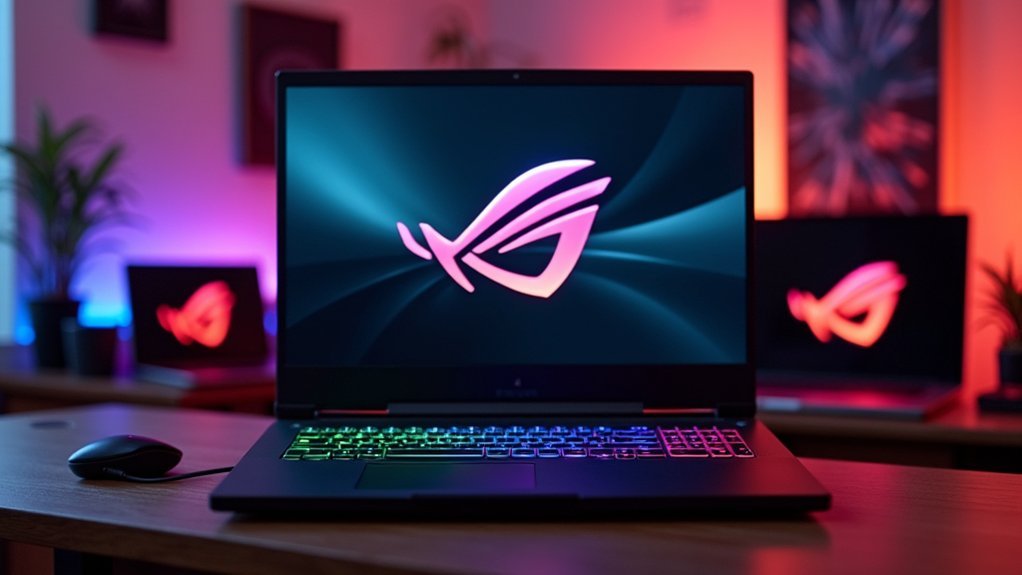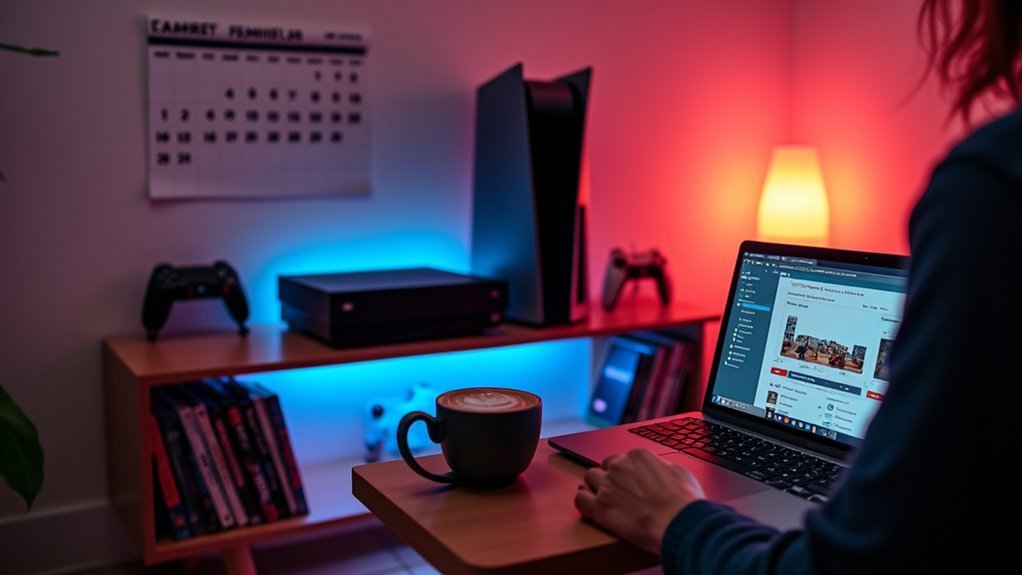You should avoid gaming laptops with all-plastic builds, mushy keyboards, and outdated GPUs like GTX 1650 or older models. Steer clear of brands like Acer’s budget Nitro series, Lenovo LOQ models, and HP’s entry-level gaming laptops that feature inadequate cooling systems and poor customer support. Look for laptops with at least 6GB dedicated GPU memory, current-generation RTX 4050 or RTX 4060 graphics cards, and solid build quality to prevent thermal throttling and performance issues that’ll plague your gaming experience for years ahead.
Warning Signs of Poor Build Quality in Budget Gaming Laptops

When shopping for budget gaming laptops, you’ll encounter several red flags that signal poor build quality and potential long-term issues.
First, avoid all-plastic constructions like the Lenovo LOQ 15, which compromise durability and longevity. You’ll also want to check keyboard quality, as budget models often feature mushy keys that hurt your typing experience – the Acer Predator Triton Neo 16 exemplifies this problem.
All-plastic builds and mushy keyboards are immediate red flags when evaluating budget gaming laptops for purchase.
Display quality matters too. The Lenovo LOQ 15’s basic screen quality, despite its 144 Hz refresh rate, shows how manufacturers cut corners.
Battery life is another concern; the Acer Chromebook Plus 516 GE’s subpar battery creates frequent recharging interruptions that disrupt your gaming sessions.
These warning signs help you identify laptops that won’t meet your gaming needs effectively.
Brands Known for Inadequate Cooling Systems
Poor thermal management plagues several budget gaming laptop brands, turning your gaming sessions into frustrating experiences filled with performance drops and overheating.
When your laptop can’t dissipate heat effectively, even your M.2 SSD performance suffers alongside your GPU and CPU.
Several manufacturers consistently struggle with cooling efficiency:
- Acer’s budget models like the Nitro V 15 feature inadequate cooling systems that cause thermal throttling during intense gaming.
- Lenovo’s LOQ 15 uses all-plastic construction that compromises heat dissipation compared to metal chassis designs.
- Asus TUF series laptops often have cooling systems that struggle under prolonged heavy usage despite decent specs.
Even gaming Chromebooks like Acer’s Chromebook Plus 516 GE run hot with less powerful components.
Always research thermal performance tests and user reviews before purchasing, as poor cooling greatly impacts gaming experience and hardware longevity.
Manufacturers That Skimp on Essential Gaming Components

You’ll find that budget gaming laptop manufacturers often cut corners on three critical components that directly impact your gaming experience.
They’ll allocate insufficient GPU memory, install substandard cooling systems that can’t handle intensive gaming sessions, and use cheap display panels with poor color accuracy and low refresh rates.
These compromises might save you money upfront, but they’ll cost you performance when you need it most.
Inadequate GPU Memory Allocation
Although budget gaming laptops may seem appealing at first glance, manufacturers often cut corners by equipping their systems with GPUs that have inadequate memory allocation.
You’ll find that many lesser-known brands offer models with 4 GB or less of dedicated GPU memory, which simply can’t handle modern gaming demands.
These insufficient specifications lead to several frustrating problems:
- Severe stuttering and low frame rates even in less demanding titles
- Poor texture quality due to limited memory for graphics processing
- Inability to run AAA games at acceptable settings
You should avoid gaming laptops featuring older cards like the Nvidia GTX 1650 or integrated graphics entirely.
Instead, look for systems with at least 6 GB of dedicated GPU memory, such as the Nvidia GeForce RTX 4050 or higher, to guarantee smooth gameplay.
Substandard Cooling Systems
Beyond memory limitations, cheap gaming laptop manufacturers frequently install woefully inadequate cooling systems that can’t handle the heat generated by gaming components. These substandard cooling systems use small, ineffective fans and cheap thermal paste that can’t properly transfer heat from your CPU and GPU to the heatsinks.
| What You’ll Experience | The Devastating Result |
|---|---|
| Excessive heat buildup | Thermal throttling kills performance |
| Frame rates plummeting mid-game | Your gaming session becomes unplayable |
| Components running dangerously hot | Shortened lifespan of expensive parts |
When your Budget Gaming Laptop overheats, you’ll watch frame rates drop dramatically during demanding titles. Research thermal performance benchmarks and user reviews before purchasing to identify brands that consistently deliver reliable cooling solutions.
Cheap Display Panel Quality
Gaming laptops from budget manufacturers often sacrifice display quality to hit aggressive price points, leaving you with washed-out colors and poor viewing angles that diminish your entire gaming experience.
When evaluating cheap display panel quality, you’ll encounter several problematic compromises:
- TN panels instead of IPS technology – These cheaper screens deliver limited color accuracy and narrow viewing angles that make your graphics card’s output look dull.
- Standard 60Hz refresh rates – You’ll miss out on smoother gameplay that 144Hz or 165Hz displays provide.
- Missing premium features – Anti-glare coatings and higher resolutions are often eliminated to cut costs.
Manufacturers like Acer and Lenovo frequently skimp on display technology in their budget models.
Even with a capable graphics card, you won’t fully appreciate your games’ visual potential through these subpar screens.
Companies With Consistently Poor Customer Support Records

When your gaming laptop breaks down or encounters issues, you’ll quickly discover that not all manufacturers provide the same level of customer support.
While premium gaming service like Nvidia maintains high standards, several budget laptop brands consistently fail their customers when help is needed most.
Premium manufacturers prioritize customer satisfaction while budget brands often abandon users during critical technical failures and warranty disputes.
Acer and Lenovo have drawn significant criticism for inconsistent support, with customers reporting excessive wait times and unhelpful responses to technical problems.
HP’s customer service ratings remain consistently poor, frustrating users seeking warranty claims or repairs.
Dell users frequently struggle reaching knowledgeable representatives and receive substandard repair services.
MSI disappoints with slow response times and inadequate support during hardware failures.
Razer gaming laptop owners often can’t obtain timely assistance when problems arise, making these brands risky investments.
Budget Laptop Brands Using Outdated Graphics Technology
You’ll find that many budget gaming laptop brands create significant GPU generation gaps by installing graphics cards that are two or more generations behind current technology.
These outdated GPUs create massive performance benchmark disparities, where you’re getting 30-40% less gaming performance compared to laptops with current-generation graphics cards at similar price points.
When you’re stuck with older GPUs like the GTX 1050 or RX 560, you can’t run modern games at acceptable frame rates or visual settings.
GPU Generation Gaps
Although budget gaming laptops might seem like attractive deals, they frequently ship with outdated GPU technology that’ll severely impact your gaming experience.
These older graphics cards can’t deliver the smooth 60+ fps performance you need for modern titles.
When shopping for budget gaming laptops, you’ll want to prioritize current-generation options like Nvidia GeForce RTX 4050 or RTX 4060 models.
Here’s what to watch for:
- Generation verification – Always check the specific GPU model number, as even small differences create substantial performance gaps
- Integrated graphics red flags – Avoid laptops using integrated graphics instead of dedicated GPUs for gaming
- Corner-cutting brands – Steer clear of manufacturers who consistently use previous-generation hardware to reduce costs
Don’t let outdated graphics technology bottleneck your gaming performance.
Performance Benchmark Disparities
Performance benchmarks reveal stark disparities between budget gaming laptops and their premium counterparts, with many low-cost models delivering frame rates that fall 30-50% below acceptable gaming standards.
You’ll find cheap laptops equipped with outdated GeForce GTX cards struggle with modern games, often failing to achieve smooth gameplay at 1080p. While Intel Core and AMD Ryzen processors may seem adequate, they’re frequently paired with graphics cards that can’t support higher refresh rate displays effectively.
Before purchasing, weigh the pros and cons carefully. Consider whether investing in a service like Nvidia GeForce cloud gaming service might be more cost-effective than buying underpowered hardware.
PC gaming demands consistent performance, and budget laptops with older graphics technology simply can’t deliver the gaming experience you deserve.
Manufacturers With High Failure Rates in Gaming Models
When shopping for a gaming laptop, certain manufacturers consistently show higher failure rates that’ll cost you more in repairs and replacements down the line.
You’ll want to exercise caution with several brands that’ve earned reputations for problematic gaming models.
Budget offerings from major manufacturers often cut corners on essential components:
- HP and Dell – Their budget gaming models suffer from inferior build quality and components unsuited for intensive gaming demands.
- Acer’s older models – Face widespread thermal management issues leading to overheating and performance degradation.
- Lenovo’s budget gaming series – Shows inconsistent reliability with premature keyboard and display failures.
Even ASUS’s TUF series has received complaints about excessive fan noise and higher failure rates in lower-priced options, while MSI’s budget models struggle with quality control issues.
Brands That Compromise on Display Quality and Performance
Beyond reliability concerns, you’ll encounter brands that severely compromise display quality and gaming performance to hit rock-bottom prices.
Many budget options from brands like Acer and Lenovo feature lower resolution screens with limited color accuracy that detracts from your gaming experience. You’ll find outdated processors and GPUs from lesser-known manufacturers that struggle with modern games, delivering poor performance and disappointing frame rates.
These laptops often sacrifice build quality, using cheaper materials that lead to durability issues over time.
Poor thermal management causes overheating and throttling during extended gaming sessions, greatly impacting performance. Additionally, you’ll deal with insufficient RAM and slower SSDs that create sluggish performance and frustratingly long load times, making these laptops unsuitable for serious gaming.
Companies Known for Misleading Marketing Claims
While shopping for budget gaming laptops, you’ll encounter manufacturers who deliberately mislead consumers through deceptive advertising tactics.
These companies exploit your desire for affordable gaming performance by presenting false or exaggerated claims that don’t match reality.
Watch out for these common misleading practices:
- Inflated battery life figures – Manufacturers advertise impressive battery duration that doesn’t reflect actual gaming usage, with real-world performance falling considerably short.
- Outdated GPU marketing – Companies promote “dedicated graphics” without revealing they’re using obsolete models incapable of handling modern games effectively.
- False cooling claims – Brands market laptops as “gaming-ready” while including inadequate thermal systems that cause overheating and performance throttling.
You’ll also find exaggerated warranty promises from brands with poor customer support histories, leaving you stranded when problems arise.
Budget Gaming Laptop Brands With Limited Upgrade Options
Another major pitfall you’ll face with budget gaming laptops is their severely restricted upgrade potential.
Many Acer and Lenovo models come with soldered RAM, preventing you from increasing memory capacity later. HP and Dell’s budget lines often lack user-accessible compartments, making GPU or cooling system upgrades impossible.
You’ll find that certain HP Pavilion models use proprietary components, effectively eliminating third-party replacement options. This design choice forces you into expensive manufacturer-specific repairs or upgrades.
Budget laptops in the sub-$800 range frequently sacrifice upgradeability to maintain lower prices, even from reputable brands.
Before purchasing, research specific models carefully. What appears to be a great deal initially can become costly when you can’t enhance performance as your gaming needs evolve.
Frequently Asked Questions
What Is a Good but Cheap Gaming Laptop?
You should consider the Acer Nitro V 15, which offers an Nvidia GeForce RTX 4050, AMD Ryzen 5 processor, 16GB RAM, and nearly 10-hour battery life for around $768.
What Brand Is the Best for Gaming Laptops?
You’ll find ASUS and Acer are the best gaming laptop brands, offering excellent performance and value. They prioritize dedicated GPUs and reliable customer support, making them top choices over pricier alternatives like Razer.
Which Laptop Can Run GTA 5 Smoothly Under $40,000?
You’ll want the Acer Nitro V 15 or Asus TUF Gaming A14 under $40,000. Both feature AMD Ryzen 5/Intel i5 processors, GTX 1650/RTX 4050 GPUs, and 8-16GB RAM for smooth GTA 5 gameplay.
Is $1000 Dollars Good for a Gaming Laptop?
Yes, $1000’s excellent for a gaming laptop. You’ll get solid 1080p gaming performance with dedicated GPUs like RTX graphics, 144Hz displays, and decent processors, though you’ll compromise on storage and premium features.




Leave a Reply